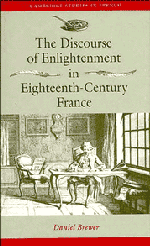Book contents
- Frontmatter
- Contents
- List of illustrations
- Acknowledgments
- Introduction
- 1 Representing knowledge: reading the Encyclopédie
- 2 Enlightenment critique and Diderot's art of philosophizing
- 3 The matter of judgment and the art of phrasing sensation
- 4 Critical narratives: Diderot's Salons
- 5 Embodying knowledge
- 6 Portraying Diderot: the aftermath
- 7 Interpreting Diderot: critical values, critical violence
- Notes
- Index
- Cambridge Studies in French
7 - Interpreting Diderot: critical values, critical violence
Published online by Cambridge University Press: 23 November 2009
- Frontmatter
- Contents
- List of illustrations
- Acknowledgments
- Introduction
- 1 Representing knowledge: reading the Encyclopédie
- 2 Enlightenment critique and Diderot's art of philosophizing
- 3 The matter of judgment and the art of phrasing sensation
- 4 Critical narratives: Diderot's Salons
- 5 Embodying knowledge
- 6 Portraying Diderot: the aftermath
- 7 Interpreting Diderot: critical values, critical violence
- Notes
- Index
- Cambridge Studies in French
Summary
Allegorical epilogue
In eighteenth-century fiction, drama, and art, the activity of reader and spectator acquires heightened significance as the esthetic object becomes part of a dialogical relation. But the esthetic object is not unique in this regard. The meaning and value of things in general becomes relative, since all objects susceptible to being known are related to the interpreting subject, the “comon center” as the encyclopedists put it. As a result, one story concerning the eighteenth-century Enlightenment would recount the emergence of a new and dialogical relation between subject and object, viewer and painting, reader and text, individual and world. The monological, authoritative discourse of a certain classicism and a certain classic subject gives way to a multiform discourse that is non-Cartesian, materialist and bourgeois, sentimental rather than tragic, novelistic rather than poetic. As it powerfully reopens the question of origins, meanings, and the authority of interpretations, the discourse of Enlightenment also confronts a crisis of its own making, which is its double bind. The encyclopedists masked that crisis by promoting practical and utilitarian knowledge, thus attempting to bypass the issue of whether Enlightenment in fact ungrounds all knowledge. And the philosophes worked to constitute systematic knowledge, seldom asking whether such synthesis could be maintained or at what price.
Diderot's role in this story is that of the steadfast skeptic with regard to such solutions.
- Type
- Chapter
- Information
- The Discourse of Enlightenment in Eighteenth-Century FranceDiderot and the Art of Philosophizing, pp. 252 - 261Publisher: Cambridge University PressPrint publication year: 1993



